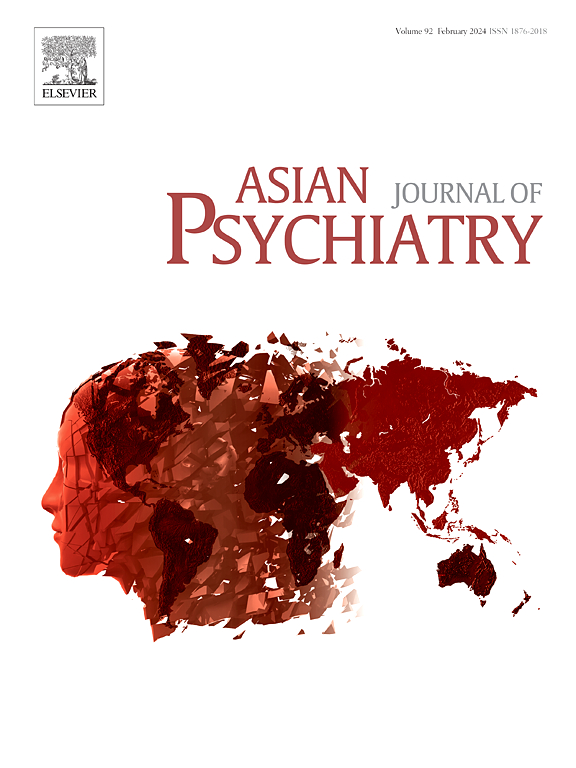印度老年人精神障碍的治疗差距和护理特征:来自2015-16年全国精神卫生调查的证据
IF 4.5
4区 医学
Q1 PSYCHIATRY
引用次数: 0
摘要
背景:印度老年人的心理健康问题仍未得到充分认识。本研究使用国家心理健康调查(2015-2016)数据集,评估了印度老年人(≥60岁)精神疾病的治疗差距和护理特征,并确定了精神疾病发病率与特定社会人口因素之间的关系。方法:对来自NMHS数据集的5590名老年人进行二次数据分析,评估治疗差距和护理特征。描述性统计总结了精神障碍的治疗模式。多因素回归确定了与当前和终生精神疾病发病率相关的因素(调整优势比[AOR], 95 %可信区间[CI])。结果:在患有任何精神障碍的老年人中,总体治疗差距为84 %,从神经症和应激相关障碍的76.9% %到严重精神障碍的90.9% %不等。中位病程为24个月,从症状发作到首次就诊之间延迟1.5-8个月。任何精神障碍的治疗差距在男性(85.5% %)中高于女性(83.6% %)。多因素分析显示,城市地铁居住(AOR: 1.510, 95 % CI: 1.223 ~ 1.863)、男性(AOR: 1.512, 95 % CI: 1.116 ~ 1.569)、年龄70岁及以上(AOR: 1.148, 95 % CI: 0.949 ~ 1.389)、家庭收入较低(AOR: 1.739, 95 % CI: 1.384 ~ 2.185)与精神疾病发病率显著相关,而高等教育程度具有保护作用。结论:巨大的治疗差距和社会人口差异突出了印度老年人需要量身定制的、可获得的和适合年龄的心理健康干预措施。本文章由计算机程序翻译,如有差异,请以英文原文为准。
Treatment gap and care characteristics for mental disorders among older adults in India: Evidence from National Mental Health Survey 2015–16
Background
Mental health issues among older adults in India remain under-recognized. This study assessed the treatment gap and care characteristics for mental disorders and determined the association between psychiatric morbidity and select socio-demographic factors among older adults (≥ 60 years) in India, using the National Mental Health Survey (2015–2016) dataset.
Methods
Secondary data analysis was conducted on 5590 older adults from the NMHS dataset to assess the treatment gap and care characteristics. Descriptive statistics summarized treatment patterns mental disorders. Multivariate regression identified factors associated with current and lifetime psychiatric morbidity (Adjusted odds ratio [AOR], 95 % Confidence interval [CI]).
Results
Among older adults with any mental disorder, the overall treatment gap was 84 %, ranging from 76.9 % for neurotic and stress-related disorders to 90.9 % for severe mental disorders. The median duration of illness was 24 months, with delays of 1.5–8 months between symptom onset and first consultation. The treatment gap for any mental disorder is higher among males (85.5 %) compared to females (83.6 %). Multivariate analysis showed that urban metro residence (AOR: 1.510, 95 % CI: 1.223–1.863), male gender (AOR: 1.512, 95 % CI: 1.116–1.569), age 70 years and above (AOR: 1.148, 95 % CI: 0.949–1.389), and lower household income (AOR: 1.739, 95 % CI: 1.384–2.185) were significantly associated with psychiatric morbidity, while higher education was protective.
Conclusion
Substantial treatment gaps and sociodemographic disparities highlight the need for tailored, accessible, and age-friendly mental health interventions for older adults in India.
求助全文
通过发布文献求助,成功后即可免费获取论文全文。
去求助
来源期刊

Asian journal of psychiatry
Medicine-Psychiatry and Mental Health
CiteScore
12.70
自引率
5.30%
发文量
297
审稿时长
35 days
期刊介绍:
The Asian Journal of Psychiatry serves as a comprehensive resource for psychiatrists, mental health clinicians, neurologists, physicians, mental health students, and policymakers. Its goal is to facilitate the exchange of research findings and clinical practices between Asia and the global community. The journal focuses on psychiatric research relevant to Asia, covering preclinical, clinical, service system, and policy development topics. It also highlights the socio-cultural diversity of the region in relation to mental health.
 求助内容:
求助内容: 应助结果提醒方式:
应助结果提醒方式:


